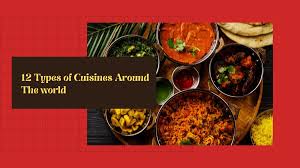The Art of Cuisine: Exploring the World Through Food
Cuisine is more than just food on a plate – it is a reflection of culture, history, and creativity. Every region in the world has its own unique culinary traditions that tell a story of its people and their way of life.
From the spicy flavors of Mexican cuisine to the delicate balance of Japanese dishes, each culture’s cuisine offers a glimpse into its heritage and values. Ingredients are carefully selected, recipes are passed down through generations, and cooking techniques are honed to perfection.
Exploring different cuisines allows us to travel without leaving our dining table. We can savor the tangy spices of Indian curries, experience the comforting warmth of Italian pasta dishes, or indulge in the rich flavors of French pastries.
Not only does cuisine provide nourishment for our bodies, but it also feeds our souls. Sharing a meal with loved ones creates bonds that transcend language barriers. Breaking bread together is a universal act that brings people together and fosters connections.
As we celebrate diversity and embrace new flavors, we expand our culinary horizons and deepen our appreciation for the art of cuisine. Whether you’re a seasoned foodie or an adventurous eater, there is always something new to discover in the world of food.
So let’s raise our glasses to the chefs, home cooks, and food enthusiasts who keep the flame of culinary creativity burning bright. Let’s savor each bite as a tribute to the rich tapestry of flavors that make up our global gastronomic landscape.
“Defining National Tastes: An Overview of American Cuisine”
“Cuisine vs. Food: Understanding the Distinctions”
4. “Lingu
- What is the most famous cuisine?
- What is considered American cuisine?
- How is a cuisine different from food?
- Do we say cuisine in English?
What is the most famous cuisine?
When it comes to the question of the most famous cuisine, opinions may vary depending on personal preferences and cultural influences. However, one cannot overlook the widespread popularity and recognition of Italian cuisine as a frontrunner in the global culinary scene. Renowned for its rich flavors, fresh ingredients, and diverse regional specialties, Italian cuisine has captured the hearts and taste buds of people worldwide. From classic pasta dishes like spaghetti carbonara to mouthwatering pizzas topped with fresh mozzarella and basil, Italian cuisine embodies a perfect balance of simplicity and sophistication that continues to enchant food enthusiasts across the globe.
What is considered American cuisine?
American cuisine is a melting pot of diverse culinary influences that reflect the country’s rich history and cultural tapestry. Often characterized by its comfort foods and regional specialties, American cuisine encompasses a wide range of dishes, from Southern barbecue and New England clam chowder to Tex-Mex tacos and Midwest casseroles. What sets American cuisine apart is its ability to adapt and evolve, incorporating flavors and techniques from various immigrant traditions while also celebrating homegrown ingredients like corn, potatoes, and seafood. Whether it’s a classic burger and fries or a decadent slice of apple pie, American cuisine is a celebration of the nation’s culinary heritage and innovation.
How is a cuisine different from food?
Cuisine goes beyond mere sustenance; it embodies a cultural identity and a way of life. While food is the physical sustenance we consume for nourishment, cuisine encompasses a broader spectrum of elements such as cooking techniques, flavor profiles, ingredient selection, and historical significance. A cuisine reflects the traditions, values, and practices of a specific region or culture, shaping not only what is eaten but also how it is prepared and enjoyed. In essence, cuisine is the artful expression of a community’s culinary heritage, while food is just one component of that intricate tapestry.
Do we say cuisine in English?
Yes, the term “cuisine” is commonly used in English to refer to a specific style or method of cooking, especially associated with a particular region or culture. When discussing food and cooking, “cuisine” is often employed to highlight the unique characteristics and flavors of a particular culinary tradition. It adds a touch of sophistication and specificity to conversations about food, allowing individuals to delve deeper into the nuances of different cooking styles and techniques.

